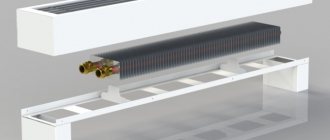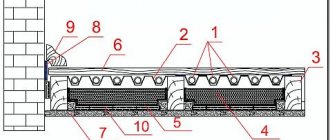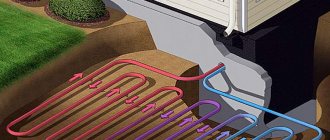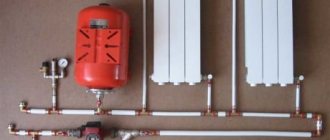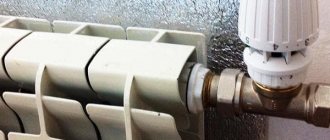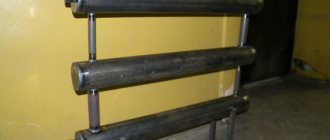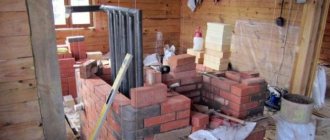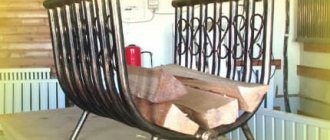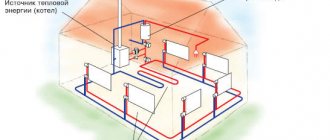Published on February 28, 2014 Category: Heat engineering |
Everyone knows that heat transfer (heat transfer) - the transfer of thermal energy - between bodies and media occurs when there is a temperature difference. A medium or body that has a higher temperature, cooling, heats the colder medium and increases its temperature.
In water heating systems, hot water (coolant), entering the heating device, heats its walls (shell). The walls, through their outer surfaces, give off heat to the air mainly in two ways: convection and radiation.
Convection is the transfer of heat to air currents flowing along the hot walls of a heating device.
Thermal radiation is the transfer of thermal energy due to the emission of electromagnetic waves by the hot walls of a heating device into the surrounding space.
A clear example of the effect of thermal radiation is a fire. If on a cool evening you stand sideways to the smoldering coals of a fire at a distance of three to four meters, then the part of your face facing the fire will quickly heat up, while the opposite part of your face will remain cold. In this case, the air temperature on both sides will be approximately the same.
All devices - cast iron radiators, heating registers made of pipes, steel and aluminum panels, convectors and infrared emitters - differ from each other (except for dimensions, appearance, heat transfer coefficients) in the predominant type of heat transfer to the surrounding air and objects. In this case, as a rule, both convection and radiation exist simultaneously and act in parallel.
This article will consider an example of calculating the heat transfer of heating registers from pipes. It has never been economically profitable to make heating registers from smooth pipes - neither today nor yesterday. If 30-50 years ago they were widely used due to a shortage of high-quality, cheap and efficient heating devices, then the use of registers today is rather an inertial habit of heating engineers. The cost of a heating system using, for example, convectors is 20-30% lower than the cost of a system using pipe heating registers. The heat transfer of devices should be maximum at minimum cost and, accordingly, minimum material consumption and labor intensity of manufacturing. However, these are often mutually exclusive criteria.
However, the issue of heat transfer from steel pipes remains relevant if they are used for wiring, as well as when performing comparative calculations of various system options and during repairs of existing systems in which heating registers made of smooth pipes are used.
Based on theory and practical experiments on heat transfer, as well as on the basis of numerous tabular data using Excel, I was able to find fairly accurate formula dependences of the thermophysical characteristics of air (thermal diffusivity, thermal conductivity, kinematic viscosity, Prandtl criterion) on temperature. Below is a program for calculating the heat transfer of heating registers from
horizontal metal pipes with free air movement,
which is the result of the work done.
The calculation program is written in MS Excel, but you can also use the OOo Calc program from the Open Office package.
The rules for formatting Excel worksheet cells that are used in the articles in this blog are presented on the “ About the Blog ” page.
Register structure
For the manufacture of heating registers, smooth carbon steel pipes with a round cross-section, as well as square and rectangular ones, are used. Their combined use is possible. Stainless and galvanized steel, aluminum, copper, and brass can also be good materials for registers, but they are much more expensive and more difficult to process with your own hands.
Heating registers made of steel profile pipes are considered the simplest to make. They can be made in two main configurations: sectional type and coil type (S-shaped).
In a sectional type register, several sections of profiled metal with capped ends are arranged in parallel and connected to each other by round tubes of smaller cross-section. The jumpers ensure that the rows of the device are filled with coolant from both sides simultaneously. Moreover, the closer to the edge the transition pipes are installed, the higher the heat transfer of the device.
In a coil register, the liquid passes in an S-shape through rows of profile pipes, gradually cooling. To add rigidity to the structure, additional blind jumpers are used. Horizontal rows are connected in pairs by a snake using tubes of a smaller cross-section, like in sectional models, or sections of the main profile. The latter option is preferable due to lower hydraulic resistance and greater heat transfer.
Connecting pipes are made with threads or welding. The most effective option for connecting a heating device is a top-down diagram. For low models and in the case of forced circulation of coolant, entry and exit from below may be justified.
The design of the register must include a Mayevsky valve or an automatic air vent. It is located at the end of the top row on a threaded fitting to allow replacement. A prerequisite for installation is to maintain a slope of 0.05% in the direction of coolant movement.
Registers can be either stationary or portable. The former work as elements of a general heating system, the latter perform the task of local heating. The heat source for a separate mobile register is a heating element with a power of 1.5-6 W, mounted in the housing.
In addition to large horizontal registers, small vertical models are also in demand. If you carry out the work carefully, you can get homemade cheap heating radiators from profile pipes that are almost as aesthetically pleasing as modern sectional radiators.
In some cases, steel registers can be a good addition to the heating units already installed in the room. Despite the lower heat transfer than radiators of a similar size, their use may be more appropriate due to their lower cost.
High vertical registers are very convenient for high rooms or near high window openings. They can successfully fit into the interiors of rooms with unusual design solutions. By experimenting a little with color and shape, you can get a creative decoration from simple heating devices.
Video
TeploEnergoProm produces heating registers from smooth and profiled pipes. We produce registers of different types, different lengths and heights, and any diameter. Call us and we will calculate the heating registers for your premises - it’s free!
When ordering from us, you work directly with the manufacturer; we have our own production area on an area of 950 sq.m. , we ensure high quality and carry out hydraulic testing of each heating device!
Type
: sectional, coil, with vertical pipes, individual;
Dimensions
: 0.4 - 10 m;
Material
: VGP pipe;
profile pipe; Diameter
: 42 - 219 mm;
Connection
: external or internal thread, flanged, welded;
Pressure
: 10 kgf/cm2 (10 atmospheres);
Section row
: 1 - 9
Painting
: Primer (red, grey), painting according to the RAL catalogue, without painting
Serpentine register . The pipes are connected by bends, so heat transfer increases and hydraulic resistance decreases. Thanks to this, you can pass a larger volume of coolant through it and save on the pump.
Section register . The pipes are connected by jumpers made of pipes of smaller diameter. Supplied with flat or elliptical plugs. It has smaller dimensions in height than type A.
Vertical-horizontal register . The pipes are connected by pipes of larger diameter, so heat transfer increases and hydraulic resistance decreases. Ensures uniform heating.
Heating of technical premises requires inexpensive and easy-to-use heating devices. For premises such as warehouses, workshops, garages and production halls, heating registers made of smooth pipes are simply irreplaceable. They are very helpful in rooms with increased requirements for cleanliness, as they are easily cleaned of dust and all kinds of contaminants.
When deciding to install heating registers, it is necessary to carefully study their technical characteristics and application features. The simplest configurations of these devices can be made independently; more complex models of ornate shapes require factory manufacturing conditions. One way or another, to ensure optimal temperature conditions, the parameters of the registers must be determined on the basis of thermal engineering calculations.
Reduced heat transfer.
In order to save energy, it becomes important to reduce the heat transfer of pipes in those sections of communications that are not used for their intended purpose, for example, when moving from one building to another or in an unheated room.
There are many options for using thermal insulation materials for this. Manufacturers offer a fairly wide range to choose from, ranging from cheap fiberglass to more expensive types of polystyrene foam. You can purchase pipes with insulating elements already built into them.
To summarize, we conclude that the use of such calculations helps to significantly save money and avoid many technical obstacles when designing water and heat supply systems.
Actually, you are a desperate person if you decide to undertake such an event. The heat transfer of a pipe, of course, can be calculated and there are a great many works on the theoretical calculation of the heat transfer of various pipes.
Let's start with the fact that if you decided to heat your house with your own hands, then you are a stubborn and purposeful person. Accordingly, a heating project has already been drawn up, pipes have been selected: either metal-plastic heating pipes or steel heating pipes. Heating radiators have also already been looked at in the store.
But, before acquiring all this, that is, at the design stage, it is necessary to make a conditional relative calculation. After all, the heat transfer of heating pipes, calculated in the project, is the key to warm winters for your family. There is no room for error here.
Methods for calculating heat transfer from heating pipes
Why is the emphasis usually placed on calculating the heat transfer of heating pipes? The fact is that for commercially manufactured heating radiators, all these calculations have been made and are given in the instructions for use of the products. Based on them, you can easily calculate the required number of radiators depending on the parameters of your home: volume, coolant temperature, etc.
Tables.
This is the quintessence of all the necessary parameters collected in one place. Today the Internet contains a great many tables and reference books for online calculations of heat transfer from pipes. In them you will learn what is the heat transfer of a steel pipe or cast iron pipe, the heat transfer of a polymer or copper pipe.
All that is needed when using these tables is to know the initial parameters of your pipe: material, wall thickness, internal diameter, etc. And, accordingly, enter into the search the query “Table of heat transfer coefficients of pipes.”
This section on determining the heat transfer of pipes also includes the use of manual reference books on heat transfer of materials. Although they are becoming more and more difficult to find, all information has migrated to the Internet.
Formulas.
The heat transfer of a steel pipe is calculated according to the formula
Qtr=1.163*Str*k*(Twater - Air)*(1-efficiency of pipe insulation), W where Str is the surface area of the pipe, and k is the heat transfer coefficient from water to air.
The heat transfer of a metal-plastic pipe is calculated using a different formula.
Where is the temperature on the inner surface of the pipeline, °C; t
c is the temperature on the outer surface of the pipeline, °C;
Q—
heat flow, W;
l
—pipe length, m;
t
—coolant temperature, °C;
t
inc—air temperature, °C;
a n is the external heat transfer coefficient, W/m 2 K; d
n - outer diameter of the pipe, mm;
l—thermal conductivity coefficient, W/m K; d
in
-
internal diameter of the pipe, mm; a int - internal heat transfer coefficient, W/m 2 K;
You understand perfectly well that calculating the thermal conductivity of heating pipes is a relative value. The formulas include the average parameters of certain indicators, which may, and do, differ from those that actually exist.
For example, as a result of the experiments, it was found that the heat transfer of a polypropylene pipe located horizontally is slightly lower than that of steel pipes of the same internal diameter, by 7-8%. It is internal, since polymer pipes have a slightly thicker wall thickness.
Many factors influence the final figures obtained in tables and formulas, which is why the footnote “approximate heat transfer” is always included. After all, the formulas do not take into account, for example, heat loss through the building envelope made of different materials. There are corresponding tables of amendments for this purpose.
However, by using one of the methods for determining the heat output of heating pipes, you will have a general idea of what kind of heating pipes and radiators you need for your home.
Good luck to you, builders of your warm present and future.
Possible installation errors
In order to avoid any technical difficulties after installation, it is necessary to provide for common errors that are often made during operation. So, if you install batteries less than 7 centimeters from the floor surface, then in the future we will be faced with the difficulty of not only cleaning underneath them, but also with heat exchange in the room. On the contrary, if you install the batteries higher than 15 centimeters, then, most likely, significant temperature changes will occur.
In addition, heat transfer may deteriorate if the radiator is installed close to the wall. Also, do not forget that you should not cover homemade pipe heating radiators with decorative grilles - this will lead to a decrease in their power.
Replacing batteries
If radiators need to be replaced, then it is advisable to start work in the warm season. The fact is that the heating is turned off during this period, so dismantling/installation can be carried out without any difficulties. Often, replacement is required if the equipment wears out or, alternatively, if it is necessary to reduce the number of sections. By the way, we prepare not only the batteries for replacement, but also the wall surfaces located behind them.
Note! We putty, level and paint the walls before installation, since after installation, as noted above, this will not be possible. Video - Replacing radiators
Video - Replacing radiators
Comparison of types of heating batteries - looking for the best
Previously, we reviewed and compared different types of heating radiators, thereby identifying their positive and negative sides; in addition to this article, we advise you to read this information
Instructions for making registers yourself
The easiest way to make your own is a steel heat exchanger, although its assembly will require skills in working with welding and grinding equipment and following certain rules.
- Before installation, it is necessary to perform calculations and a drawing, which will indicate the dimensions of pipes and connecting elements, the location of fittings and connection points. The drawing will help you accurately calculate the quantity and parameters of consumables.
- The clearance between sections is taken to be 1.5D or D+0.5 cm, where D is the diameter of the pipe. The distance between parallel sections of the coil register is calculated depending on the arc element used or the turning radius (R) when using a pipe bender. In the first case, the distance is equal to twice the difference between the height of the arc element (F) and the diameter: 2(FD). In the second case, the distance will be 2R-D. With a smaller distance, heat transfer decreases.
- Since welding and grinding equipment is used during installation, be sure to wear protective clothing and shoes, and protect your face with a special mask or goggles.
- For efficient operation of the register, strict parallelism of its sections is necessary; a level, plumb line and construction angle will help to control this parameter during the work.
- An air vent is installed at the top point of the register, farthest from the supply pipe, to get rid of air pockets in the circuit. When installing a parallel heat exchanger with collectors, air vents are placed at the top point of each collector.
- To secure the register you will need stands and brackets. The more massive the structure, the more fasteners will be required.
Work order
- The work area is being cleaned.
- The register elements are marked and cut in accordance with the drawing.
- The inner and outer surfaces of the pipes, as well as the edges of the holes, are cleaned of debris and rust with a steel brush.
- The plugs are cleaned of debris and plaque. Holes are drilled in two plugs for connection to the heating circuit.
- Plugs, jumpers and connecting pipes or manifolds are welded in accordance with the drawing. The parallelism of the sections is checked after joining each element.
- Welds are cleaned.
- The tightness of the resulting register is checked: the outlet hole is hermetically sealed, and water under pressure is poured through the input hole. If even small drops appear on the seams, it is necessary to drain the liquid and further boil the seam.
- If necessary, coat the heat exchanger with heat-resistant metal paint.
- The register is secured to supporting and hanging elements.
- Connected to the heating system.
Using cross-linked polyethylene for heated floors
Metal-plastic is very convenient as a material for a pipeline that will be hidden under your floor and will have to warm the feet of you and your family. Metal-plastic is multi-layered, so it is not susceptible or minimally susceptible to corrosion, lasts more than fifty years, the pipes have a large footage (from 50 to 500 meters), in addition, they have low linear elongation when heated.
Connections can be detachable, conditionally detachable and permanent. Detachable fittings include threaded and collet fittings; for conditionally detachable ones - compression ones, and for non-detachable ones - press fittings. Of course, it is necessary to buy both the pipes themselves and fittings only from reliable and trusted manufacturers.
Metal-plastic floor pipes have many advantages, but they also have some disadvantages. These disadvantages can be very significant if you are not warned about them in advance.
So, firstly, due to the different expansion coefficients of the polymer and aluminum, spontaneous expansion may occur and/or the pipes may crack (a phenomenon that professionals call pipe delamination will occur). Secondly, if you use threaded fittings for installation, then scale may form on their inside. Therefore, it is better to use exclusively press fittings (of course, when possible).
Despite a number of significant disadvantages, today metal-plastic pipes for floor heating are the best and most used option for those who value comfort, long service life of the product, as well as their own safety and the safety of their family. They have good thermal conductivity and have multiple advantages.
How to properly weld a heating register
The individual structural elements are assembled together by welding metal. This can be done in any way convenient for you. How to weld a heating register correctly? In fact, it all depends on what kind of welding machine you have:
- electric arc (manual, semi-automatic);
- gas.
Electric arc manual welding machines are the most widely used, as they are the cheapest and simplest. With this device you can both connect metal parts and cut them. On large parts you need to cut holes for the pipes. This should be done near the edge, retreating one diameter of the pipe. There will be four holes on the middle section, two on the first and outer sections.
Holes for connecting pipes
After this, on a flat horizontal surface we lay out all the elements in one structure and make tacks at the base of the pipes. You need to make either two tacks along the equator of the pipe, or three evenly around the entire circumference, as in the Mercedes badge. If the position of the tacks is incorrect, the part may fail during welding. After making sure that the register geometry is correct, you can proceed to welding.
While working in the melting bath, you need to maintain a high temperature and distribute the molten metal. The electrode must constantly move along a certain trajectory. How to weld a heating register, the simplest trajectories of electrode movement:
- left - right (herringbone);
- forward - backward (with influx).
The most important point is the formation of the root of the weld on the tack and the exit from the tack. The process is performed with a gap, since the welder needs to change the position of the electrode. Although, with proper skill, you can cook without interruption. After the seam has cooled, you need to knock off the sludge with a hammer. So, all that remains is to weld the ends with plugs, which must first be cut from metal of the same thickness.
As a result, we have a blank in which holes for supply and return, as well as an air vent, will be cut in the future. The air vent, the same Mayevsky valve, removes air pockets that reduce the efficiency of the heat exchanger. You can also read in more detail about the air in the heating system. Connecting the registers to the heating system is the last stage, after which you can carry out a hydraulic test and put the equipment into operation.
In addition, this blank can be used to manufacture a register with an electric heating element. A hole for the heating element is cut out in the lower end, and an open-type expansion tank is installed in the upper part.
Welding technology
Purely technologically, the connection of steel elements is made either by electric or gas welding, where the technology is almost the same
When welding registers, please note that in coil structures the joints are vertical seams, and in sectional ones they are both vertical and horizontal. It is easier to cook the latter because they are located in the plane of the table
The following requirements apply to the technology of welding horizontal seams (section + jumper):
- Tack can be carried out at one or two points, aligning the jumper vertically. Two points are located symmetrically relative to the axis of installation of the jumper.
- A joint connected by one tack point is cooked immediately, but the process must begin on the opposite side of the tack.
- A joint connected by two tack points is welded from the first point.
- Vertical joints in registers - connection of main pipes with plugs and 90° bends. The following requirements apply to seams of this type:
- If the pipe thickness is up to 3 mm, then the joint is scalded in one pass with a 2.5 mm electrode.
- If the thickness exceeds 4 mm, then welding is carried out in two passes: with a root seam, and on top with a facing roller.
- When connecting pipes with a diameter of more than 60 mm, welding is carried out in sections along the entire perimeter of the joint.
There are general rules of welding, which indicate purely technological techniques. For example, the end of a seam must be welded to the beginning, forming a “lock”. If welding is performed in two seams, then the second is carried out in the opposite direction of the first.
There are several welding parameters that you need to pay attention to when carrying out welding work. This is the diameter of the electrode, which is selected depending on the thickness of the steel workpieces being welded, this is the current strength supplied to the electrode from the welding machine, the polarity and voltage of the welding arc
Ratio of metal thickness to electrode diameter
| Metal thickness, mm | 1—2 | 3—5 | 4—10 | 12—24 | 30—60 |
| Electrode diameter, mm | 2—3 | 3—4 | 4—5 | 5—6 | 6 or more |
The current strength is selected depending on the diameter of the selected electrode. The dependence is as follows: I=Kd, where K is the coefficient of correlation with the diameter of the electrode.
| Electrode diameter, mm | >2 | 3 | 4 | 5 | 6 |
| Coefficient - "K" | 25—30 | 30—35 | 35—40 | 40—45 | 50—60 |
We make a calculation
The formula by which heat transfer is calculated is as follows:
Q = K*F*dT, where
- K – thermal conductivity coefficient of steel;
- Q – heat transfer coefficient, W;
- F is the area of the pipe section for which the calculation is being made, m 2 dT is the value of the temperature pressure (the sum of the primary and final temperatures taking into account room temperature), ° C.
The thermal conductivity coefficient K is selected taking into account the area of the product. Its size also depends on the number of threads laid in the premises. On average, the coefficient is in the range of 8-12.5.
dT is also called temperature difference. To calculate the parameter, you need to add the temperature that was at the outlet of the boiler with the temperature that was recorded at the entrance to the boiler. The resulting value is multiplied by 0.5 (or divided by 2). The room temperature is subtracted from this value.
dT = (0.5*(T 1 + T 2)) - T to
If the steel pipe is insulated, then the resulting value is multiplied by the efficiency of the insulating material. It reflects the percentage of heat that was given off during the passage of the coolant.
Types of heating registers
Heating registers are a group of pipelines located parallel to each other and communicating with each other. They may differ in material, shape and design.
Materials for production
Most often, heating registers are made of smooth steel pipes in accordance with GOST 3262-75 or GOST 10704-91. The use of electric welded pipes is preferable due to their ability to withstand higher pressures. However, in practice, water and gas pipes are also quite common, and they are operated no less successfully. Such heating devices can easily withstand all kinds of mechanical damage and loads, as well as work with any coolant.
There are also stainless steel models. They are installed in rooms with increased requirements for aesthetics and durability. Due to the increased cost, the use of stainless steel registers is most justified in bathrooms. The high corrosion resistance and variety of configurations of stainless steel heated towel rails allow them to be used even in the most modern bathroom interiors.
Aluminum and bimetallic registers are more efficient in terms of heat transfer. They are lightweight and aesthetically pleasing, and work perfectly in individual heating systems with well-organized water treatment. In other cases, low quality coolant leads to rapid failure of devices.
Sometimes you can find registers made of copper. They are usually used in systems where the main wiring is copper. They are easy to work with, very attractive and durable. In addition, the thermal conductivity of copper is approximately 8 times higher than steel, which makes it possible to significantly reduce the size of the heating surface. A common disadvantage of all devices made of non-ferrous metals - sensitivity to operating conditions - limits the scope of application of copper registers.
Design
The most characteristic designs of traditional steel registers can be divided into 2 types:
- Sectional;
- Serpentine.
The first is characterized by a horizontal arrangement of pipelines and the use of vertical narrow jumpers between them. The second involves the use of straight and arcuate elements of the same diameter, which are connected by a snake using welding. When using stainless steel or non-ferrous metals, the pipes are simply bent to give the required configuration.
There are three options for connecting pipes:
- Threaded;
- Flanged;
- For welding.
They can be located either on one side of the device or on different ones. The coolant outlet is provided under the supply or diagonally from it. Sometimes there is a lower connection of lines, but in this case the heat transfer is significantly reduced.
In sectional registers, there are 2 types of connections depending on the method of arranging jumpers:
- "Thread";
- "Column".
Plain tube registers can be used as registers for the main heating system or as separate heaters. For autonomous operation, a heating element of the required power is installed inside the device and connected to the network. Antifreeze or oil is often used as a coolant for portable electrical registers made of steel, because... it does not freeze during storage or during a power outage.
When used separately from the general heating system, it is necessary to additionally place the expansion tank in the upper part of the device. This avoids pressure increases due to volume expansion during heating. The size of the container is selected based on the ability to accommodate about 10% of the total amount of liquid in the heater.
For autonomous use of the register made of steel pipes, legs with a height of 200 - 250 mm are welded to it. If the device is part of a heating circuit, its movement is not planned and the walls are strong enough, then a stationary mount is used using brackets. Sometimes for very massive registers a combined installation option is used, i.e. The device is placed on stands and additionally fixed on the wall.
Specifications
Technical requirements for heating devices, including tubular radiators, are standardized by GOST 31311-2005. According to this standard, pipes in accordance with GOST 3262, GOST 8734, GOST 10705, GOST 10706 with a wall thickness of at least 1.25 mm must be used for their manufacture. At the same time, heated towel rails are allowed to be made from carbon steel with a wall of at least 3 mm, stainless steel, as well as brass (copper-zinc alloys) in accordance with GOST 15527.
It is also possible to use other materials if the heating devices comply with all provisions of the standard and have the necessary strength characteristics. The design of devices is not standardized and remains at the discretion of the manufacturer, subject to compliance with basic requirements. This gives complete freedom for creativity and allows you to create unique design configurations of tubular radiators, which significantly expands the scope of their application.
*
The characteristics of heating registers made of smooth pipes depend on the selected material, size and configuration. They are determined using special formulas, tables or manufacturer’s materials.
Let's consider the main parameters of conventional steel registers. They are characterized by the use of large diameter pipes, mainly in the range of 32 – 219 mm. They can withstand operating pressure up to 100 Pa (10 kgf/m²). The coolant can be a variety of liquids - water, antifreeze, oil - or high-temperature steam.
Having a detailed drawing, a register from smooth steel pipes can be made by any craftsman with welding skills. To do this, just find the source material, a welding machine and an angle grinder. You can also order the register at the factory according to individual drawings.
Important! It is necessary to maintain not only the length, diameter and number of pipes, but also the distance between them. Too close a location significantly reduces the heat transfer of the device due to the mutual influence of the elements. If the distance is made too large, then the height of the device can be enormous and not convenient to install and use. The optimal spacing of the rows of the heating register is considered to be 1.5 radii, but not less than 50 mm.
To obtain the best results, all parameters must be determined on the basis of thermal calculations, based on the required heat transfer and the characteristics of the room. Without proper calculation, even a well-made register may not be able to cope with heating the available area.
Installation methods: welding or threading?
The biggest problem when carrying out installation work on assembling and installing heating registers is welding work. Heating appliances are assembled from individual parts outside the room, and then the heating system is installed from the prepared blanks using gas welding. Welded seams can be replaced with threaded connections, which are inferior in strength and durability, but if the work technology is followed and modern materials are used, they can ensure long-term operation of heating equipment.
A heating register in a garage or warehouse is an independent device that allows you to heat a technical room using electricity
Application of thermal insulation materials
Probably the first thing that comes to mind when it is necessary to retain maximum heat inside a pipe is to wrap it with heat-insulating material. At the end of the last century, fiberglass insulation with additional winding with non-flammable fabric was used for these purposes (this method is recommended by the regulatory framework). A little earlier, solutions of gypsum or cement were actively used, that is, the thermal insulation was solid. In reality, careless plumbers often simply wrapped the pipes with old rags, hoping that no one would check.
The abundance of modern materials, such as foam pipe linings, split polyethylene shells, mineral wool and others, allows for much better thermal insulation of heating pipes. And in new buildings such materials are successfully used. However, the backwardness of housing and communal services often leads to the fact that pipes are wrapped in rags the old fashioned way.
Classic designs of heating registers
Option #1 - horizontal register
Most often, when manufacturing a heating register, two or three parallel pipes laid horizontally are connected. The distance between adjacent sections in the register must necessarily be 50 mm greater than the diameter. Coil designs of registers are also popular, divided into several types depending on the method of connecting devices to the heating system.
Heating registers of coil type: L - length of the heating device, D - pipe diameter, h - distance between pipes (50 mm greater than the diameter)
The length of the heating devices is selected in accordance with the dimensions of the room or room in which it is planned to install the heating system. In addition to the listed types of heating register designs, there are also:
- single-pipe products;
- four-pipe devices;
- five-pipe models, etc.
The number of pipes used in one heating register depends on the area of the heated room, the quality of the object’s thermal insulation, the presence of other heat sources in the room, etc. By sorting through the possible pipe diameters, the optimal dimensions of the products are calculated, at which the optimal temperature regime will be maintained in the heated room.
Horizontal heating registers made of smooth pipes are used for lower piping. In this case, the products are carefully placed around the perimeter of the room closer to the floor surface. In a residential building, pipes go under the windows. In industrial premises, the location of heating devices depends on the height of the ceilings, the layout of the facility and the placement of industrial equipment.
Heating registers successfully heat social facilities. Caring for such heating devices is much easier than cast iron radiators.
Option #2 - vertical registers
When remodeling apartments and expanding their living space with balconies and loggias, it is necessary to dismantle the batteries installed by the developer when handing over the property. In this case, the dismantled radiators are replaced with vertical heating registers welded from a large number of round pipes of small diameter. These heating devices are placed in a wall located next to the window opening.
If necessary, vertical heating registers are covered with decorative grilles, which turn an essential element of the heating system into an interior decor item. You can disguise the location of the “bundle” of parallel pipes using mirrors, colored glass, mosaics, wrought iron grilles, as well as by placing shelves, hangers, cabinets and other useful items of non-bulky furniture.
It is possible to ensure the movement of coolant in a vertical register installed in an autonomous heating system of a private house using a circulation pump. Horizontal registers are also used for natural coolant circulation, if they are installed with a slight slope (0.05% is sufficient).
Advantages and disadvantages
Heating registers made of smooth pipes have many advantages:
- For large premises they are one of the best options for heating devices. Due to their considerable length, they provide uniform heating and create comfortable conditions. The heating is not local, but extensive.
- The hydraulic resistance is very low compared to cast iron or steel radiators. This allows you to significantly reduce pressure losses in the system, and, accordingly, the costs of pumping coolant. This same feature makes it possible to use an open heating system with natural circulation for large rooms.
- Straight sections of large diameter pipes are less susceptible to silting and overgrowing, unlike radiators of complex shapes. Therefore, heating registers practically do not need to be flushed.
- A simple design can be made with your own hands from available materials with significant savings.
- The service life is quite long, at least 25 years. The degree of reliability depends mainly on the quality of the welds.
- The smooth surface makes cleaning easy. This feature allows registers to be used in rooms with increased sanitary standards.
- Convenient for drying towels, linen and clothes.
*
The disadvantages of registers made of smooth pipes include:
- Small heating surface per unit length, which forces the use of large-sized devices;
- High metal consumption;
- Large diameters force the use of a large volume of coolant, which makes the system very inertial and difficult to regulate;
- The unattractive appearance of budget models and the huge price of non-standard design configurations.
How to install a heating register
Every owner can install a heating register without involving a specialist in the work. To simplify assembly operations, it is first necessary to prepare each element of the heating system according to the project.
One of the main requirements is a high-quality connection of the register with pipelines. It must withstand the maximum permissible load - 10 MPa. If the joining is done by welding, you need to monitor the quality of the seams.
It is recommended to place registers along one wall. In this case, a minimum slope in the direction of movement of the coolant is required - up to 0.05% of the length of the device.
Heating registers must be located closer to the floor surface. The larger the diameter of the main pipe, the less resistance there will be for the circulating coolant.
The efficiency of the device depends on a large number of factors, including the heating area, which is directly proportional to the length and diameter of the pipes. The most widely used models in everyday life are those with the following characteristics:
- Recommended pipe diameter – from 25 to 160 mm
- Connecting jumpers for sectional models – from 30 mm
- Distance between main pipes – from 50 mm
- Maximum pressure – 10 MPa
- Material – high carbon steel
We make a register with our own hands
Anyone who knows how to work with a welding machine is able to make a heating register on their own. The simple design can be filled with antifreeze or oil.
Introductory video on production
To make a heating device with your own hands, it is recommended to follow the instructions:
- It is necessary to prepare pipes of suitable diameters and cut the blanks
- The inside of the pipe is checked and, if necessary, cleaned to reduce the already high resistance to the circulating coolant
- Plugs are welded at the ends, holes are drilled in some of them
Tubes of a smaller diameter (vertical) are connected to thicker ones (horizontal). It is necessary to install taps to remove air that will accumulate from the edges. All seams are carefully and efficiently cleaned, the surface is painted with oil paints.
In portable structures, it is necessary to install a heating element with a power of 1.5 to 6 W, which will operate from a regular outlet. If the system is powered by a heating boiler, the efficiency of the registers can be increased by installing a powerful circulation pump.
We calculate the return for 1 m of product
It is easy to calculate the heat transfer of 1 m of pipe made of steel. We have a formula, all we have to do is substitute the values.
Q = 0.047*10*60 = 28 W.
- K = 0.047, heat transfer coefficient;
- F = 10 m2, pipe area;
- dT = 60° C, temperature difference.
It's worth remembering
Do you want to make a heating system correctly? You should not select pipes by eye. Heat transfer calculations will help optimize construction costs. In this case, you can get a good heating system that will last for many years.
The thermal conductivity of steel is quite high - this is a law of physics, and one cannot argue with it. But you can turn this property of metal to your advantage. It is this heat transfer that allows steel to be used in the production of various devices for heating rooms.
